Navy Radio Traffic Handling, Circuits, and Message Processing
Afloat Communications Systems - 1972 Radioman A School Training
Material
- See More Training Material Here
I. A BRIEF EXPLANATION OF THE NAVAL COMMUNICATIONS SYSTEM
(from "Fleet Multi-channel Broadcast Traffic Intensity Study" by
LCDR Harlan Daryl Oelmann, June 1972 - 8MB
pdf)
A. ORGANIZATION OF THE NAVAL COMMUNICATIONS SYSTEM
The Naval Communications System is composed of 27 Naval Communications
Stations (NAVCOMMSTAs ) , 4 Naval Communications Units (NAVCOMMUs) and several
Naval Radio Stations (NAVRADSTAs). These stations are located throughout the
world and are organized into several Naval Communications Areas (NAVCOMMAREAs) .
The primary purpose of these stations is to relay messages to and from ships of
the fleet andshore establishments within their area of responsibility.
The stations within a NAVCOMMAREA are organized under one NAVCOMMSTA which is
designated as the Naval Communications Area Master Station (NAVCAMS) while the
other stations are designated as Naval Communications Area Local Stations
(NAVCALS) . Although the communication means which each of these stations use
take several forms, such as teletype, voice and CW, etc. , this study is
concerned only with teletype communications and the fleet broadcast system.
Therefore discussion will consider only those areas.
B. TELETYPE COMMUNICATIONS
It is assumed that to most readers, teletype communications is a familiar
means of communication which does not require detailed explanation, except to
note that when messages are handled physically within a station they are handled
in teletype tape or chad tape form. Hence in further discussion when we speak of
messages being handled in a station it is implicitly meant that such messages
are in tape form unless otherwise stated.
1. World Wide Teletype Communications
The Defense Department World Wide telecommunications system controlled by the
Defense Communication Agency provides for long-haul and point-to-point
telecommunications between communications stations of the Armed Forces which
include the NAVCOMMSTAs and other stations within the NAVCOMMAREAs . This system
is known as the AUTODIN network which is a digital high speed message
transmission system.
2. Local Teletype Communications
The primary means of communications between a NAVCOMMSTA and the ships at sea
is a teletype system which operates at the rate of 100 words-per-minute (wpm),
where one teletype word is equivalent to 5 teletype characters.
There are essentially three methods of teletype communication between the
ships at sea and the shore based NAVCOMMSTA.
- The first is a ship-shore telecommunication link which are time shared
circuits used by several ships at sea, these circuits provide the capability
to send messages to a NAVCOMMSTA for further relay and delivery.
- The second method is also a ship-shore link which is a dedicated circuit,
sometimes called a full period termination circuit, between one ship and the
NAVCOMMSTA. This type of circuit is normally used by the larger ships such
as aircraft carriers and cruisers, which normally have staffs embarked. The
full period termination circuit provides the capability for these ships to
send messages to the NAVCOMMSTA for further relay and also to receive from
the NAVCOMMSTA messages which are addressed to that particular ship or
embarked staff.
- The third method is the fleet broadcast system. This system is the primary
means of delivering traffic to the fleet as a whole because it provides for
simultaneous delivery of messages to the operating forces dispersed over a
large geographical area. This method also employs a 100 wpm teletype system
which could be described as a one-way system because the broadcast system
enables the NAVCOMMSTA only to send messages while the ships can only
receive messages.
The fleet broadcast system is composed of several different types of
broadcasts. These are the fleet multichannel broadcast, on which this study is
based, a single channel broadcast for ships that are not equipped to copy the
multi-channel broadcast, the submarine broadcast and a merchant ship broadcast.
In some NAVCOMMAREAs these broadcasts are all operated by one NAVCOMMSTA or
Broadcast Control Station (BCS) while in other NAVCOMMAREAs these separate
broadcasts are operated by two or more NAVCOMMSTAs . Also if the capability of
flexibility exists, a separate additional broadcast may be created within a
NAVCOMMAREA to handle special traffic load situation. Sometimes a NAVCAMS may
shift a broadcast to a NAVCALS in an emergency or to maintain proficiency among
the capable NAVCALS in operating the broadcast.
C. MESSAGE PRECEDENCES AND SPEED OF HANDLING
Naval communications messages are assigned one of four precedences. Each
message precedence has a Speed of Service Criteria, which is a time standard for
a message to take in transmission from the origination of the message to the
receipt of the message by the addressee. These criteria are shown in Table XVI
below. The letter in parenthesis is the designator of the precedence.
TABLE XVI - SPEED OF SERVICE CRITERIA
| Precedence |
Average Speed
of Service |
Limits |
| Flash (Z) |
As fast as
humanly possible |
Same |
| Immediate (O) |
30 minutes |
30 minutes-1 hour |
| Priority (P) |
3 hours |
1-6 hours |
| Routine (R) |
6 hours |
3 hours-to the start of
the next business day |
II. THE FLEET MULTI-CHANNEL BROADCAST SYSTEM
There are normally five fleet multi-channel broadcasts operated in the Naval
Communications System. Each broadcast which serves a particular ocean area is
operated by a designated NAVCOMMSTA or Broadcast Control Station. These
broadcasts have designations of NMUL, EMUL, KMUL, FMUL and GMUL, where FMUL
serves the Eastern and Mid-Pacific Ocean area and is normally operated by
NAVCOMMSTA San Francisco [10].
A. CHANNEL ALIGNMENT AND USE
The fleet multi-channel broadcast is a multiplex system which has 8 separate
100 wpm teletype traffic channels which are transmitted on a single carrier
frequency. The alignment of the traffic channels is such that the overall
broadcast traffic load to the fleet is segregated on the basis of ship type
where each subscriber is served by two traffic channels, a primary channel and a
secondary channel. An example of the overall broadcast channel alignment,
channel designations and uses of each channel is shown in Table XVII below.
TABLE XVII - FMUL-BROADCAST CHANNEL ALIGNMENT
| Channel |
Designation |
Use |
| 1 |
FASW |
Destroyer force primary traffic channel |
| 2 |
FSPC |
1 hour delayed rebroadcast of channel 1 or overload as
necessary |
| 3 |
FALD |
Service, Amphibious and Mine force primary traffic channel |
| 4 |
FUSN |
1 hour delayed rebroadcast of channel 3 or overload as
necessary |
| 5 |
FNSC |
Major warships (carriers, cruisers, large destroyers,
including flagships) primary traffic channel |
| 6 |
FOPI |
Special traffic channel (NAVSECGRU) |
| 7 |
FHIC |
1 hour delayed rebroadcast of channel 5 or overload as
necessary |
| 8 |
FMET |
Weather traffic channel |
B. THE RECEPTION SIDE OF THE BROADCAST
The fleet multi-channel broadcast system for each channel is a guard system.
This means that each subscriber copying a particular channel screens each
sequentially serial-numbered message sent on that channel to determine whether
that particular message is addressed to him or not. If the message is for the
ship or for the embarked staff the message is processed. If it is not for that
particular ship or embarked staff the message is ignored and filed. Hence a
subscriber must perform two necessary actions. He must determine from the
message heading (which contains the addressees) whether the ship or embarked
staff is an addressee or not. If the message is addressed to the ship then it
must be copied without errors from beginning to end. That is the addressee must
have a clear enough copy that he is able to obtain all the information
transmitted without any doubt as to what the message says.
If a subscriber has missed part or all of the heading such that he cannot
determine whether the message was addressed to him or not, or if he has missed
part or all of the text then we will refer to such a message as a "missed
message."
A message may be missed for various reasons, some of which are: environmental
or atmospheric conditions, which cause deterioration of the radio signal,
equipment failure on the ship or in some cases error in judgment of the operator
monitoring the teletype printer.
C. PROCEDURE FOR OBTAINING MISSED MESSAGES
If a subscriber copying a particular channel has missed one or more messages
he must determine whether the message(s) was addressed to him and if necessary
he must obtain a complete copy of the message. He is first encouraged to obtain
a copy from another ship copying the same broadcast channel, providing the
subscriber has a separate means of communication with the other ship. When the
subscriber exhausts all local means of obtaining this information his next
action is to originate a message which is called a "service or screen
request message." Such a message is usually sent to a NAVCOMMSTA requesting
them to verify or screen their copy of the broadcast to determine whether the
message (s) in question is for the subscriber. The NAVCOMMSTA will in turn reply
by indicating which messages are of no concern to the subscriber and by
rerunning on the primary channel those messages which were addressed to the
subscriber.
A subscriber which misses only a portion of a message may service only for
that portion of the message to which the NAVCOMMSTA must in turn originate a
service message in reply giving the subscriber that portion of the message
missed.
It is noted that in some NAVCOMMAREAs, the NAVCOMMSTA to which a screen
request is sent may not be the Broadcast Control Station. In these cases
designated NAVCOMMSTAs in the NAVCOMMAREA also copy the broadcast and serve as
stations which handle screen requests for a particular channel of the broadcast.
When these NAVCOMMSTAs process a screen request their replies are relayed via
AUTODIN to the Broadcast Control Station which in turn sends the reply on the
appropriate broadcast channel. We note that these replies are handled in the
same manner as first run messages.
D. HANDLING OF SERVICE MESSAGES AT A NAVCOMMSTA
Some NAVCOMMSTAs will handle screen requests for more than one broadcast
channel or in some cases for more than one type of broadcast system. At each
NAVCOMMSTA all such broadcast screen requests are usually handled at one
broadcast service desk. The broadcast service desk handles these requests on the
highest precedence first and on a first-in first-out basis within precedences.
These service messages are usually referred to as screen requests, since the
service desk clerk is required to "screen" the heading of the missed
messages in the printed copy form of the broadcast channel log to determine if
the message is for the requesting subscriber. Additionally, to clarify
terminology, each message looked up is referred to as a "screen." Thus
a "screen request" may contain one or more "screens.
After the service desk clerk determines the result of a screen request he
then must make teletype tape copies of the messages to be rerun, if necessary,
which are forwarded to the appropriate broadcast channel position for
transmission.
At some NAVCOMMSTAs, when the service desk clerk has finished the screen and
before he prepares the rerun tapes he prepares a short message to the requester
indicating which messages are of no concern to the subscriber and additionally
states that those messages which are of concern will be rerun later.
Other NAVCOMMSTAs use the procedure where they include this information with
the first message rerun and only after the entire screen request has been
processed.
It is apparent that this process is a very time consuming task and explains
the reason why subscribers are encouraged to seek other sources for verification
before asking the NAVCOMMSTA.
E. TRANSMISSION SIDE OF THE BROADCAST
Considering now the transmitting side of the broadcast we look at the
NAVCOMMSTAs internal handling of messages which are destined for transmission on
one or more of the broadcast channels. Messages arrive at the broadcast area in
teletype tape form and are, depending on individual NAVCOMMSTA configurations ,
primarily delivered to each broadcast channel position by two 850 wpm
reperforators called "burpees" [Teletype model BRPE]. The traffic
delivered by the burpees is traffic which has been received by the NAVCOMMSTA
from the AUTODIN network or from 100 wpm teletype circuits which terminate at
the NAVCOMMSTA from any number of sources. The burpees are fed from these
various sources through a small computer system called the Multiple Address
Processing Unit (MAPU).
This system reads the header of a message which contains address codes as to
where a message is destined within the NAVCOMMSTA and routes that message to the
appropriate relay positions by delivering a teletype tape through the burpees.
In addition to the burpee deliveries some NAVCOMMSTAs hand deliver screen
request answers, reruns and other messages to the broadcast position. The screen
request answers and reruns are then usually put at the head of the line or queue
for transmission.
Messages delivered to the broadcast position are put in a grid (queue) by
precedence and in order of arrival within each precedence. The messages are then
taken from the grid and put in the channel transmitter distributor (TD), a
device which reads the teletype tape for transmission. The order in which the
messages are taken from the grid for transmission is on the highest precedence
waiting and first in first out (FIFO) within a precedence basis. This process at
some NAVCOMMSTAs is done by one man physically performing the queuing process
while another man pulls the tapes from the grid and places them into the TDs for
transmission. At other NAVCOMMSTAs, properly equipped, this entire process is
handled by a small computer system, known as the "tight tape" system.
NAVCOMPARS - "The Naval Communications Processing and
Routing System: A Model for Management"
NPS Thesis - LCDR Michael D. Barker & LCDR William R. Lawrence -
1974
download
pdf
|
This thesis represents the results of a study of the U. S.
Naval Processing and Routing System (NAVCOMPARS). The system's development
from preconception to present is described herein as well as a description
of its hardware and software components. Additionally, the Local Digital
Message Exchange (LDMX) , is likewise described. The purpose of this
thesis is to identify bottlenecks in message flow through NAVCOMPARS. In
this attempt, the system was simulated in a functional manner by computer
and various input distributions were applied. By so doing, the factors,
events and situations contributing to bottlenecks in message processing
are identified as fully as possible within the constraints of time and
information availability. |
NAVCOMPARS - "The Naval Communications Processing and Routing System :
Analysis of an Automated System"
NPS Thesis - LT Beth M. Hintz - 1976
download pdf |
This thesis is designed to present a detailed description
and analysis of the Naval Communications Processing and Routing System (NAVCOMPARS).
Discussed are the objectives and principles of the Naval
Telecommunications Automation Program (NTAP) , with emphasis placed on
delineating the shore components, particularly NAVCOMPARS. The
capabilities of NAVCOMPARS are identified by describing the patterns of
message flow through the automated system. Also considered are the
manpower and training characteristics and the projected link with
the Information Exchange Subsystem (IXS). A model of the central
processing unit is presented in order to highlight the sequence of
procedures employed by an automated message processing system. The
underlying intent of this thesis is to provide a compact document which
could be used as introductory material to acquaint non-computer
specialists with the characteristics, requirements and potential of the
Naval Communications Processing and Routing system. |
|
"Naval Communications Processing and Routing System (NAVCOMPARS):
A Model for Broadcast Performance Analysis"
NPS Thesis - LT Gary L. George - 1983
download pdf |
This thesis represents an analysis of the performance of the
Naval Telecommunications System's (NTS) multichannel broadcast. It
highlights the speed differential between the Naval Communications
Processing And Routing System's (NAVCOMPARS) processing subsystems and the
multichannel broadcast's transmission lines. |
"The Naval Telecommunications System: A Command and
Staff Manual"
NPS Thesis - LCDR Robin M. Babb - 1987
download
pdf
|
This thesis provides prospective Naval communications
managers, senior officers, and supervisory command and control officers
with a basic, non-technical description of the Naval Telecommunications
System (NTS). It is suitable as a general primer for the communications
manager, for new personnel indoctrination, for command briefings, and for
general reference to the NTS. This thesis includes a description of the
organic structure, administration, and operation of the NTS, its
interaction with various major commands and agencies, the primary systems
used within the NTS, and some plans for its future. |
|
|
|
Full-period termination operator (FPT) — receives
messages from ships via either single channel or multi-channel
terminations, and oversees the sending of messages to ships terminated
with the NavCommSta. Honolulu utilizes the NavComPars to key outgoing
traffic addressed to terminated units. When it becomes necessary for the
ship/shore operator to talk to the terminated ship, he asks the command
VDT operator to hold the appropriate termination LRN, and then the
operator talks directly to the ship using a UGC-61 keyboard. At this
station, the FPT also enters received traffic into the data speed reader.
One operator handles two termination channels, and two data speed readers
are operational at Honolulu. Primary Ship-Shore operation is similar but
on-demand rather than FPT.
Dedicated circuits operator — five of the eight
dedicated circuits at Honolulu are operated directly on-line with the
NavComPars. Two circuits with Australia and one with New Zealand are
operated on a torn-tape basis, interfacing termination style circuits with
an AUTODIN access terminal. Operation is similar to the full-period
termination. |
Full Period Termination - FPT Receive
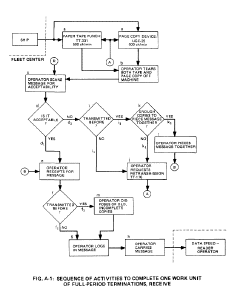 |
Data Speed Reader -
FPT Receive > NAVCOMPARS input
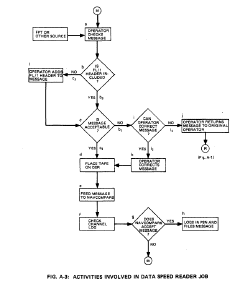 |
FPT Transmit
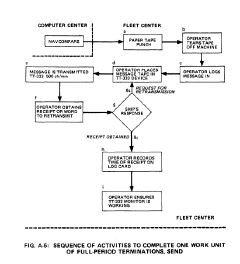 |
Primary Ship-to-Shore
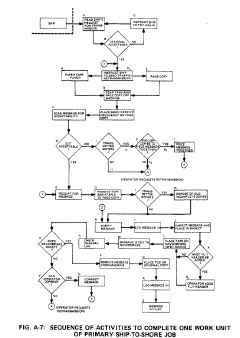 |
|
Allied interchange operator — basically handles the
duties outlined in description for dedicated circuits operator. Also works
full-period terminations with allied ships, and assists in keying the
allied broadcast, when activated. The purpose
of the Allied/NATO/SEATO circuit is to provide Allied ship-shore service. |
CW broadcast operator — converts teletype
messages into CW format, and places them on proper broadcast schedule
(that is, at proper time).
PG Broadcast is similar but RATT, not CW |
Allied/NATO/SEATO - Receive
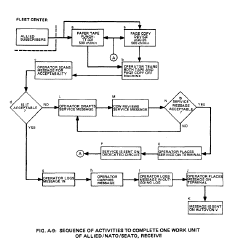 |
Allied/NATO/SEATO - Transmit
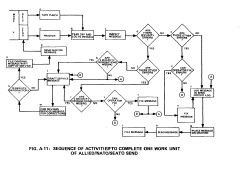 |
CW Broadcast
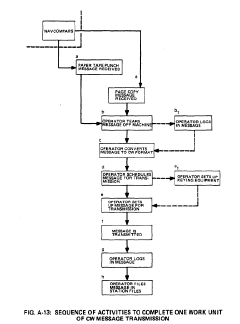 |
Patrol Gunboat Broadcast
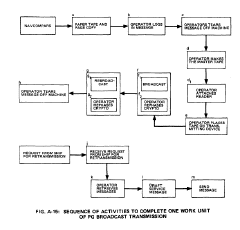 |
|
Off-line crypto operator — encrypts and decrypts
messages from or to commands for which this station has crypto guard.
Handles all classified messages which require special handling during his
watch. |
Router VDT operator processes messages rejected because of
format or routing errors |
Miscellaneous |
Offline Encryption
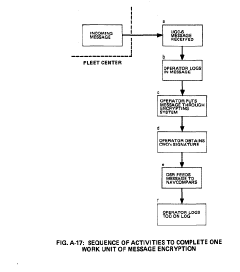 |
Offline Decryption
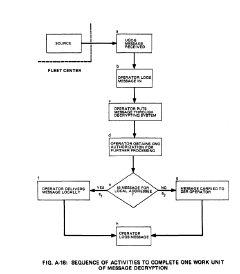 |
Router VDT
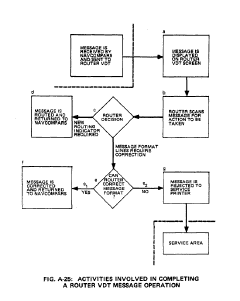 |
Service Center
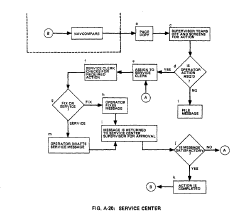 |
|
|
Fleet Multichannel Broadcast System
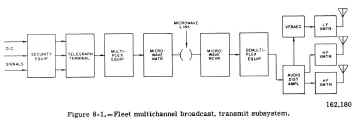
Fleet multichannel broadcast - Transmit (Shore Station)
|
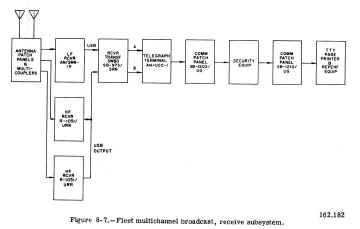
Fleet multichannel broadcast - Receive (Shipboard) |
HICOM
Because the requirements for rapid communications from the Department
of the Navy to the fleet operational commanders had changed, the CNO authorized
the activation of an additional teletypewriter system. This system, known as
HICOM, was activated in 1957 and operated parallel to the existing
communications channels.
Later, the Commander in Chief, U.S. Pacific Fleet (CINCPACFLT), established
an additional parallel circuit known as the "Atomic Strike Coordinator
Circuit." It was determined that even more rapid communications would be
necessary. Therefore, a new communications net, known as the "Naval
Operation Net" was formed in 1959.
from NCTAMS EASTPAC history
|
High Command Communications Network (HICOM)
The HICOM network provides a voice link between the Chief of Naval Operations (CNO) and all subordinate commands ashore, afloat, and airborne. CNO is the master control station and each fleet commander in chief has an area network control station. All naval communications stations are members.
In cases where a fleet unit is suffering communications difficulties with normal channels, HICOM is used on a not-to-interfere basis to restore
communications. All naval communications stations are required to guard HICOM for their respective area networks and use this system
from current USN training manual
|
Golf System
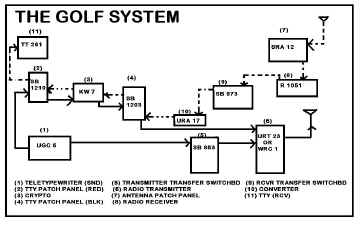
|
Charlie System
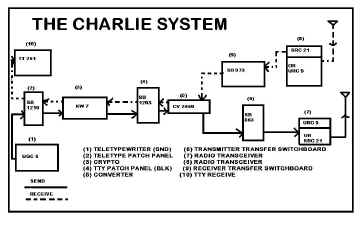
|
Uniform System
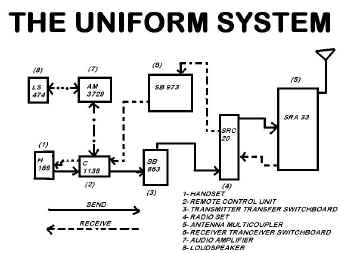
|
November HF System
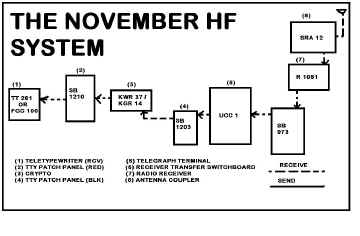
|
US NAVY COMM STATION (1954)
The control center may be called the nerve center of the Naval Communication Station for through this area pass all radio circuits to and from the overseas activities as well as landline facilities with continental activities. In outward appearance, the area resembles a telephone exchange.
The control of landline circuits is, in fact, very similar to the operation of a telephone exchange. Circuits are made normal (balanced, compensated, or matched) throughout their entire length on a continuous basis except when landline casualties occur. In such cases, substitute radio facilities are provided.
The communication equipment which is controlled from this area covers a rather wide range of telegraph and telephone application. The teletypewriter is the primary unit of telegraph equipment used at present on both radio and landline circuits. Manual radio (CW) operating facilities are available when needed.
Continuity of communications on the circuits to and from the COMMCEN is the responsibility of the control center personnel. They patch (connect) circuits to the appropriate terminal equipment. Circuit signals are monitored in the control center, and adj ustments made to keep the signals of maximum quality. Operators keep informed as to the conditions on the circuits. Whenever frequency shifts are necessary they inform the transmitting and receiving stations, and the distant
stations. Control center operators make the connections for the teletypewriter and telephone conference calls. They monitor the latter.
The equipment in the control center includes a supervisory control console, radiotelephone switchboard, and devices for the control, measuring, and monitoring of both direct current and tone circuits. In addition there are the single sideband and multiplex equipments used for high speed communications, the carrier control equipment used with the radio link to the transmitting and receiving stations, and the speech privacy gear for telephone conference calls.
US NAVAL COMMUNICATIONS STATION FLEET SUPPORT (1954)
When a NAVCOMMSTA provides facilities for primary fleet support, they may include :
1. A primary fleet broadcast.
2. A primary general broadcast.
3. A primary ship-shore high frequency (HF) manual CW circuit.
4. A ship-shore medium frequency (MF) manual CW circuit as required.
5. A ship-shore very high frequency (VHF) radioteletypewriter (RATT) harbor circuit as required.
6. A ship-shore ultra-high frequency (UHF) duplex RATT harbor circuit as required.
7. Ship-shore high command high frequency (HF) RATT circuit as required.
8. A ship-shore HF radiotelephone circuit as required.
9. A ship-shore MF radiotelephone circuit as required.
10. A ship-shore VHF radiotelephone harbor circuit as required.
11. A ship-shore UHF radiotelephone harbor circuit as required.
12. Point-to-point wire and radio circuits for external or inter-area communication as required.
13. Local wire and radio circuits as necessary for local and casualty communication.
14. Monitoring of distress frequencies and handling of distress traffic as required.
15. Interconnection with commercial communication systems as required.
16. Interconnection with Army, Air Force, or other Federal agency communication systems or networks as required.
US NAVY RATT BROADCASTS (1954)
The Washington Primary Fleet RATT Broadcast schedules (designator WILLIAM ROGER) transmit traffic to ships in the Washington primary fleet broadcast area which are equipped to copy RATT. Ships copying WILLIAM ROGER do not copy WILLIAM (CW Fleet Broadcast), except during the former's maintenance period, or whenever it is closed down due to equipment failure.
Messages to be broadcast by RATT are delivered by the outgoing traffic desk to the WILLIAM ROGER position, except in the case of high precedence traffic,
then the same procedure is followed as was noted for WILLIAM high precedence traffic. The RATT operator time-stamps messages upon receipt and inspects them for accuracy of routing, heading, and text. He then transmits them in order of precedence and TOR. He types them on a Model 19 teletypewriter, which produces a page copy and a chad (completely perforated) tape. Page copies are retained for files
and the tape fed into a T-D at a speed of 60 w.p.m.
A guard list consisting of the call signs and delivery groups of ships and commands copying WILLIAM ROGER is transmitted once each day.
Fleet broadcast message format
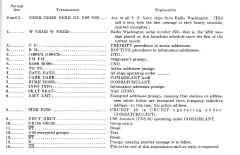
1964 Fleet Broadcast Areas
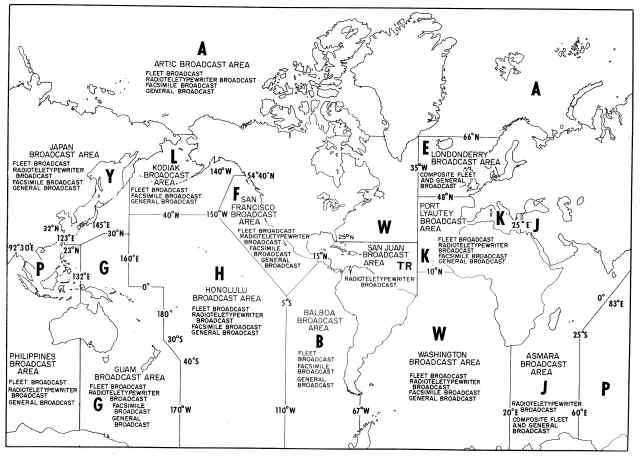
1957 Naval Communication System TTY Network

1945 NTX System
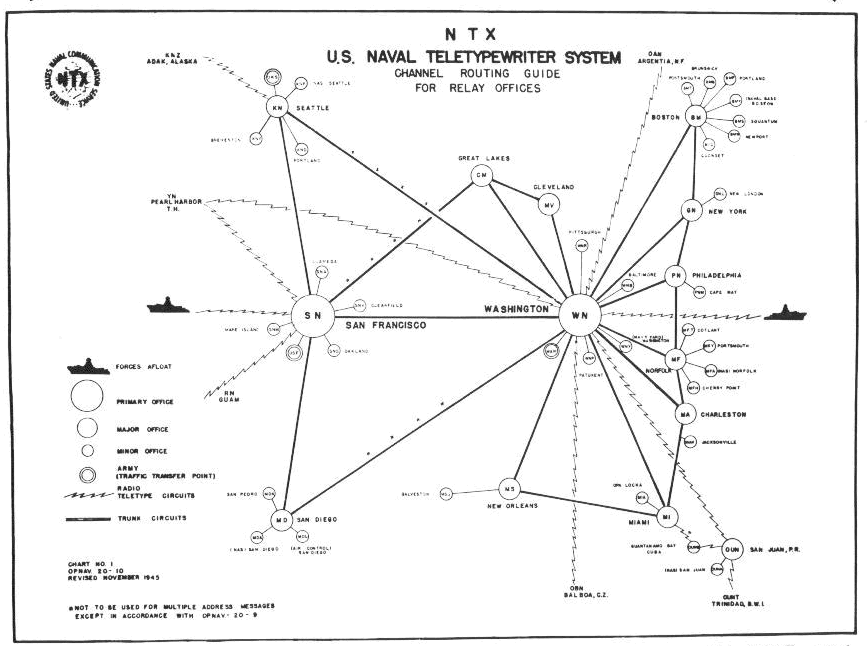
Interesting messages illustrating Navy communications operations
- released by NSA relating to 1967 USS Liberty incident - message index here
and here
NAVCOMMSTA Morocco daily report of operations -
NAVCOMMSTA Greece message handling
USS Liberty message routing
Z-Grams From CNO ADM Elmo Zumwalt - all
messages
R 251505Z SEP 70
FM CNO (Z-35)
TO: NAVOP
UNCLAS //N11101//
BOQ/BEQ CONVENIENCES
A. SECNAVINST 1700.11
B. OPNAVNOTE 1700 OF 10 SEP 1970
1. RECENT CONSTRUCTION OF NEW BOQ/BEQ’S AS WELL AS MODERNIZATION OF
EXISTING FACILITIES HAS IMPROVED HABITABILITY FOR OUR BACHELOR PERSONNEL.
HOWEVER, CONVENIENCES AND PRIVILEGES AFFORDED PERSONNEL RESIDING THEREIN ARE NOT
COMMENSURATE WITH THOSE ENJOYED BY PERSONNEL RESIDING IN BASE QUARTERS OR
PRIVATE RENTALS. A CONCERTED EFFORT AT ALL LEVELS ALONG WITH INGENUITY ON THE
PART OF CO’S IS REQUIRED TO ALLEVIATE THIS SITUATION. ONE AREA OF SUCH
DISPARITY IS IN THE POSSESSION AND CONSUMPTION OF ALCOHOLIC BEVERAGES IN
QUARTERS. THIS DISPARITY WAS PARTIALLY ALLEVIATED BY REFERENCE (B) WHICH
CLARIFIED THE INTENT OF REFERENCE (A) WITH RESPECT TO PERMITTING POSSESSION AND
USE OF ALCOHOLIC BEVERAGES IN ROOM TYPE BEQS.
2. AS A FURTHER STEP IN THIS AREA, AND SUBJECT TO THE PROVISIONS OF PARAGRAPH
9 OF REF A, BASE/STATION COMMANDERS WITHIN THE UNITED STATES AND OVERSEAS ARE
ENCOURAGED TO INSTALL BEER VENDING MACHINES IN BOQ’S AND SENIOR BEQ’S FOR
USE OF THE OCCUPANTS THEREOF. SUCH USE SHOULD BE SUBJECT TO REGULATIONS ISSUED
BY BASE/STATION COMMANDERS. OUR SECRETARY OF THE NAVY, MR JOHN CHAFEE, HAS
AUTHORIZED AN EXCEPTION TO PARAGRAPH 8 OF REF A TO PERMIT THE FOREGOING
PRACTICE.
3. NAVY POLICY REGARDING THE USE OF ALCOHOLIC BEVERAGES BY MEMBERS OF THE
NAVY IS TO ENCOURAGE ABSTINENCE, ENFORCE MODERATION AND PUNISH OVERINDULGENCE. I
RECOGNIZE OUR JUNIOR OFFICERS AND SENIOR PETTY OFFICERS AS MATURE, RESPONSIBLE
PEOPLE AND AM CONFIDENT THAT SUCH A CONVENIENCE WILL NOT BE ABUSED. E. R.
ZUMWALT, JR., ADMIRAL, U.S. NAVY, CHIEF OF NAVAL OPERATIONS.
BT

















